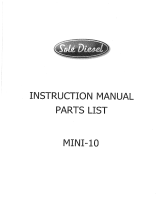
8
Introduction
This operator's manual has been compiled to help you get the most from your Volvo Penta engine. It contains all
the information you need in order to operate and maintain your engine safely and correctly. Please read the
operator's manual carefully and learn how to operate the engine, controls and other equipment safely.
Always have the operator's manual available. Keep it in a safe place and do not forget to give it to the new owner
if you sell your boat.
Care of the environment
We would all like to live in a clean and healthy envi-
ronment. Somewhere where we can breathe clean
air, see healthy trees, have clean water in our lakes
and oceans, and are able to enjoy the sunshine wit-
hout being worried about our health. Unfortunately,
this cannot be taken for granted nowadays but is
something we must work together to achieve.
As a manufacturer of marine engines, Volvo Penta
has a special responsibility, why care of the environ-
ment is a core value in our product development.
Today, Volvo Penta has a broad range of engines
where progress has been made in reducing exhaust
emissions, fuel consumption, engine noise, etc.
We hope you will take care in preserving these qua-
lities. Always follow any advice given in the instruc-
tion manual concerning fuel grades, operation and
maintenance and you will avoid causing unecessary
interference to the environment. Get in touch with
your Volvo Penta dealer if you notice any changes
such as increased fuel consumption exhaust smoke.
Adapt speed and distance to avoid wash and noise
disturbing or injuring animal life, moored boats, jetti-
es, etc. Leave islands and harbours in the same
condition as you want to find them. Remember to
always leave hazardous waste such as waste oil,
coolant, paint and wash residue, flat batteries, etc.,
for disposal at a destruction plant.
Our joint efforts will make a valuable contribution to
our environment.
Running-in
The engine must be run in for its first 10 operating
hours as follows:
Operate the engine normally. Do not operate it at full
load except for short periods. Never run the engine at
a constant engine speed for long periods during the
running-in period.
The engine can be expected to use more engine oil
during the running-in period than would otherwise be
normal. Check the oil level more often than is
normally recommended.
The prescribed warranty inspection “First Service
Inspection“ must be carried out during this first pe-
riod of operation. For more information: See the
Warranty and Service Book.
Fuel and oils
Only use the fuel and oils recommended in the chap-
ter Technical Data. Other grades of fuel and oil can
cause operating problems, increased fuel consump-
tion and, in the long-term, a shorter engine service
life.
Always change oil, oil filters and fuel filters at the
recommended intervals.
Service and replacement parts
Volvo Penta marine engines are designed for high
operational reliability and long service life. They are
constructed to withstand the marine environment
while also affecting it as little as possible. Through
regular service and the use of Volvo Penta original
spare parts, these qualities will be retained.
The Volvo Penta worldwide network of authorized
dealers are at your service. They are specialists in
Volvo Penta products and have accessories and the
original replacement parts, test equipment and special
tools necessary for high quality service and repair
work.
Always follow the maintenance intervals contained in
the operator's manual. Remember to state the engine/
transmission identification number when ordering
service and replacement parts.
7741986 - Downloaded from www.volvopenta.com 06/10/2006 13:10:27






























